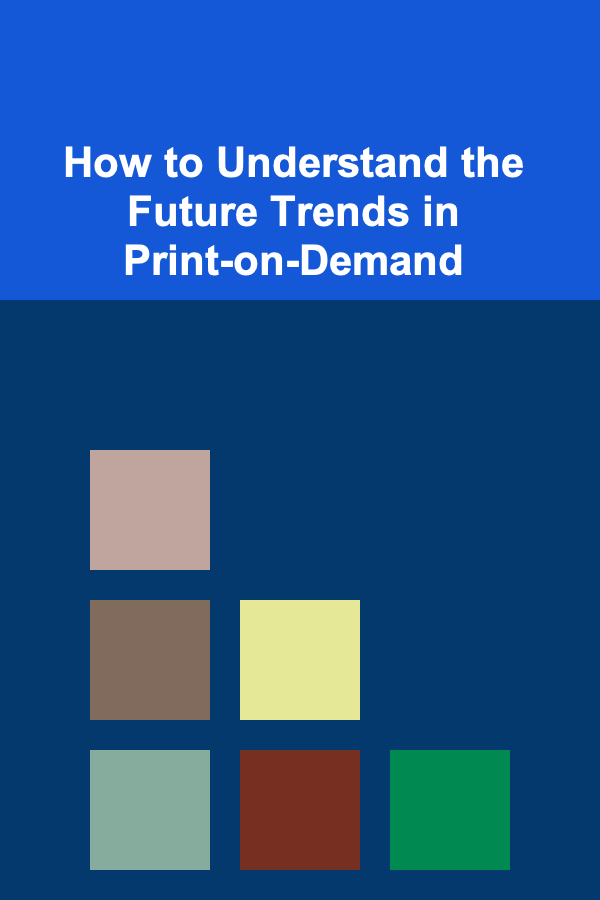
How to Understand the Future Trends in Print-on-Demand
ebook include PDF & Audio bundle (Micro Guide)
$12.99$8.99
Limited Time Offer! Order within the next:

Print-on-Demand (POD) has evolved from a niche service into one of the most revolutionary models in the print industry. In recent years, the growth of e-commerce, coupled with advancements in digital printing technology, has brought POD to the forefront of the business world. But what does the future hold for this ever-evolving industry?
This article delves into the trends, technological advancements, and potential challenges in Print-on-Demand, exploring the dynamics of this industry from both a business and consumer perspective. Understanding these future trends will help businesses and individuals navigate and take advantage of the opportunities in POD.
The Evolution of Print-on-Demand
Before we explore the future trends, it's essential to understand how POD has evolved. Initially, POD was a service primarily used for small-scale, personalized orders. Authors used POD to print books, eliminating the need for large print runs and the associated inventory costs. However, with the rise of e-commerce platforms and marketplaces like Etsy, Amazon, and Shopify, POD has expanded to various niches, from custom apparel to home decor.
The global shift towards personalized and unique products has fueled the demand for POD. It has become a model that benefits creators, designers, and entrepreneurs by providing an efficient, cost-effective way to create and sell custom products without the need for large-scale manufacturing facilities or substantial upfront investments.
Key Trends Shaping the Future of POD
1. Customization and Personalization
One of the most significant trends in POD is the growing demand for customized products. Today's consumers value individuality, and they are increasingly looking for ways to express their unique styles. From personalized T-shirts to custom-designed phone cases, POD allows customers to design products that reflect their tastes.
In the future, this trend will likely intensify as technology advances. The ability to personalize not just the design, but also the material, texture, and even the functionality of a product will open new avenues for customization. Tools that enable customers to create their own designs with ease and precision will continue to emerge, providing a more seamless experience for both creators and consumers.
2. Advanced Printing Technology
The rapid advancement in printing technology is transforming the POD industry. Traditional printing methods, like screen printing, are being replaced by more advanced digital printing techniques. These include Direct-to-Garment (DTG) printing, sublimation printing, and laser engraving.
DTG, in particular, has revolutionized the apparel sector by allowing for high-quality, full-color prints on fabric, even in small quantities. This trend will continue to evolve, with new techniques making it possible to print on more diverse materials, including 3D printing, and even integrate new technology such as nanotechnology for smarter, more durable prints.
3. Integration with Artificial Intelligence and Automation
Automation and AI are playing an increasingly important role in the POD industry. AI can optimize production lines by predicting demand, managing inventory, and reducing production times. It can also enhance personalization, allowing POD platforms to recommend designs or products based on customer preferences, browsing history, and purchase behavior.
In the future, AI will not only enhance production efficiency but also improve customer experiences. For instance, AI-powered design tools can automatically adjust images for various products or predict color combinations that might appeal to customers. Furthermore, AI chatbots are expected to handle customer service tasks, allowing businesses to scale their operations more efficiently.
4. Sustainability and Eco-friendly Practices
Sustainability is a growing concern for consumers and businesses alike. The POD industry, often criticized for its waste and carbon footprint, is beginning to address these issues by incorporating more sustainable practices into its operations.
As more consumers demand eco-friendly options, POD platforms are responding with sustainable materials, such as organic cotton, recycled fabrics, and eco-friendly inks. The rise of carbon-neutral shipping practices and biodegradable packaging is also helping to mitigate the environmental impact.
In the future, we can expect sustainability to become a key factor in choosing POD providers. Companies that adopt eco-friendly practices will likely have a competitive edge, particularly as eco-conscious millennials and Generation Z continue to influence consumer behavior.
5. Globalization of POD
The globalization of e-commerce has led to the expansion of POD services worldwide. While POD was once predominantly popular in Western countries, it is now gaining traction in emerging markets, including Asia, Latin America, and Africa. As more entrepreneurs look to sell globally, POD offers a scalable solution without the need for international warehousing or distribution.
In the future, the international reach of POD will only grow. Shipping technologies will continue to improve, and POD providers will adapt to local markets, ensuring that entrepreneurs can easily tap into international consumer bases without the need for physical stores or large-scale operations.
6. Subscription Models and Recurring Revenue
Another emerging trend is the rise of subscription-based POD services. Businesses can offer customers a recurring delivery of customized products, whether it's monthly personalized clothing, custom prints, or other unique items. This model allows businesses to build a more consistent revenue stream while giving customers the convenience of receiving tailored products on a regular basis.
As POD providers continue to integrate with platforms like Shopify, WordPress, and others, businesses will be able to offer seamless subscription models. These models will become more personalized and dynamic, with the ability to adjust based on individual customer preferences and purchasing habits.
7. Augmented Reality (AR) and Virtual Try-Ons
The rise of augmented reality (AR) is beginning to make its mark on the POD industry, particularly in fashion and home decor. AR allows customers to virtually try on clothing or see how a piece of furniture will look in their home before making a purchase. This reduces the likelihood of returns and enhances the shopping experience.
In the future, AR could become a standard feature in POD platforms, especially as consumers demand more interactive and immersive shopping experiences. For example, customers might be able to visualize their custom T-shirts in a 3D view or see a mug design come to life with animation, helping them make more confident buying decisions.
8. Blockchain for Transparency and Authenticity
As the demand for transparency in product sourcing grows, blockchain technology could play a pivotal role in the future of POD. Blockchain can provide an immutable record of each product's origin, from the design to the final shipment, ensuring that customers receive authentic and ethically-produced goods.
In the future, blockchain could allow POD businesses to verify their supply chains, track carbon footprints, and provide customers with verifiable claims about product sustainability and ethical practices. This level of transparency will be crucial as consumers continue to demand accountability from the brands they support.
The Challenges Ahead for POD
While the future of Print-on-Demand looks promising, there are several challenges that businesses in this industry will need to address in order to thrive in the coming years.
1. Supply Chain and Logistics Challenges
As POD expands globally, managing the logistics of production and delivery will become more complex. Ensuring quick turnaround times, minimizing shipping costs, and addressing local regulations will all present hurdles. Businesses will need to partner with reliable suppliers and shipping companies to ensure that they can meet customer expectations.
2. Intellectual Property Concerns
As the ability to easily create and sell custom designs increases, so do the risks of intellectual property theft. Designers and creators may face challenges in protecting their work from infringement. In response, POD platforms will need to implement stricter mechanisms to protect intellectual property rights and prevent unauthorized use of designs.
3. Market Saturation and Competition
As the barriers to entry in POD are relatively low, the industry is becoming increasingly competitive. With so many entrepreneurs entering the market, distinguishing a brand and standing out in a crowded market will be a challenge. Companies will need to focus on providing exceptional quality, customer service, and unique products to stay ahead of the competition.
Conclusion
The future of Print-on-Demand is exciting, with technological advancements and shifting consumer expectations driving significant changes in the industry. From personalized products to advanced printing technologies and sustainability efforts, the POD landscape will continue to evolve rapidly. As the industry matures, businesses will need to stay agile, innovate continuously, and address challenges head-on in order to thrive.
For entrepreneurs and creators, understanding these trends is crucial for positioning themselves in a competitive and fast-moving market. By embracing new technologies, offering unique customer experiences, and adapting to global shifts, the future of Print-on-Demand holds incredible potential.

How to Build a Checklist for Lawn Care and Maintenance
Read More
How to Create a Family Book Club and Make Reading Fun
Read More
How to Maximize Storage in Your Small Apartment
Read More
How to Prevent Burglary Using Neighborhood Watch Programs
Read More
How To Create a Minimalist Living Room
Read More
How to Understand the Glycemic Index of Foods
Read MoreOther Products

How to Build a Checklist for Lawn Care and Maintenance
Read More
How to Create a Family Book Club and Make Reading Fun
Read More
How to Maximize Storage in Your Small Apartment
Read More
How to Prevent Burglary Using Neighborhood Watch Programs
Read More
How To Create a Minimalist Living Room
Read More